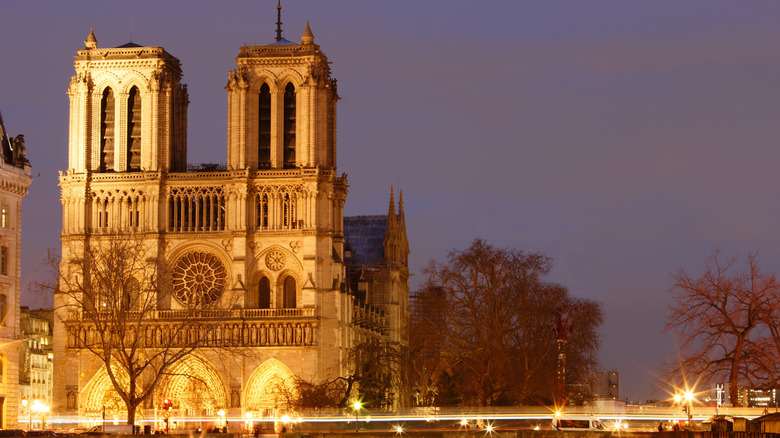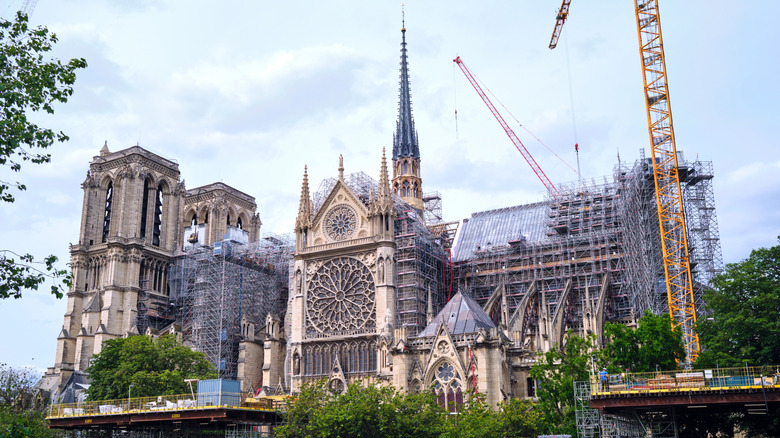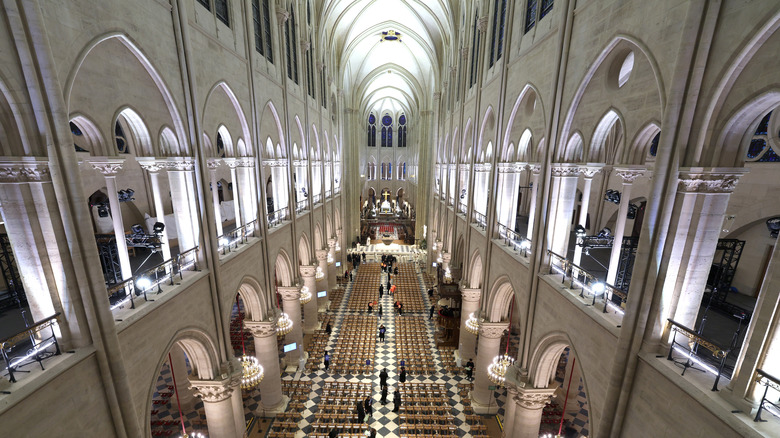Paris' Notre Dame Cathedral Has Officially Reopened. Here's What To Know Before Visiting
April 15, 2019, was a terribly sad day for many people around the world. Regardless of their denomination or whether they had visited Paris or not, millions watched aghast as a devastating blaze took hold of Notre Dame Cathedral in the French capital. It was a cultural tragedy unfolding before our eyes. The cathedral had stood overlooking the River Seine since the 14th century and is one of the most beloved symbols of the city. Parisians went to bed that night wondering if anything would be left standing in the morning, and it was touch-and-go for a while. Yet five years later, Notre-Dame de Paris has opened its doors to the public again. Here's what you need to know.
Given the extent of the fire, it is perhaps surprising that it has only taken five years to restore the vast Gothic building, one of the most sacred Catholic sites in the world. The tons of ancient timber supporting the roof fuelled the flames for many hours, and there was a real risk that the medieval stonework would also succumb to the fire. Thankfully, firefighters managed to save the bulk of the structure and its priceless relics without loss of life. The French President — Emmanuel Macron — vowed to restore the cathedral and almost $1 billion was raised in donations while the wreckage was still smoking. Now, visitors will see how the money has been spent as Notre Dame is ready to inspire devotion and wonder for many more centuries to come.
What is so special about Notre Dame?
Notre-Dame de Paris is one of the world's must-see historic structures that took hundreds of years to build. Construction of the cathedral began in 1163 and was finally completed in 1345, almost 150 years after its creator's death. Over the centuries, it gained fame for its 8,000-pipe organ, enormous stained glass windows, gargoyles leering out over the flying buttresses, and the golden rooster that became the national emblem of France.
In popular culture, the cathedral is arguably best known from Victor Hugo's 1831 novel "The Hunchback of Notre Dame" and its many film versions, and the author has perhaps done more than anyone to popularize and save the building. The 2019 fire wasn't the first time the cathedral had faced a mortal threat. It was badly damaged during the French Revolution and stood in disrepair until Hugo's classic story helped raise public awareness and prompt much-needed repairs.
The modern restoration project was a major undertaking that enlisted the help of around 500 artisans, masons, carpenters, architects, and generous donors to bring Notre Dame back to its former glory. A commitment was made to emulate the original craftsmanship and building techniques as much as possible while also building in safety features to ensure that another similar disaster wouldn't occur — critical since the new roof is constructed in timber sourced from around 1,000 oak trees. The interior, which had grown somewhat gloomy over the centuries, now dazzles with its bright stonework and brilliant frescoes.
Notre Dame is open to the world once again
On December 7, 2024, Notre Dame Cathedral's largest bell (dating back to 1683) was rung, marking the opening of a ceremony that was attended by around 1,500 dignitaries including Emmanuel Macron, Jill Biden, Prince William, and many more. The event was followed by an "Octave of Reopening," which included the return of the Crown of Thorns relic that is said to be the original from the crucifixion of Jesus Christ, before Notre-Dame de Paris re-opened for regular service again on 16th December.
Needless to say, it will be a busy time for the freshly restored landmark, with people from all over the world jostling with regular worshippers to get a look inside. It is a must-see, whether you have one day in Paris or plenty of time. The cathedral is open from 8 a.m. to 7 p.m. every day, until 10 p.m. on Thursdays, and it is recommended that visitors reserve a free time slot in advance to cut down on waiting times. A reservation isn't compulsory, but you should expect queues if you show up without one. To find out more about the cathedral, you can download a mobile app (in English, French, or Spanish) or stop by the reception desks as you enter. It is worth noting that there are no public restrooms inside Notre Dame, and you should approach a visit as you would any other sacred site. The cathedral is an amazing sight but it is also an active place of worship, so visitors should dress modestly and behave quietly and respectfully.


